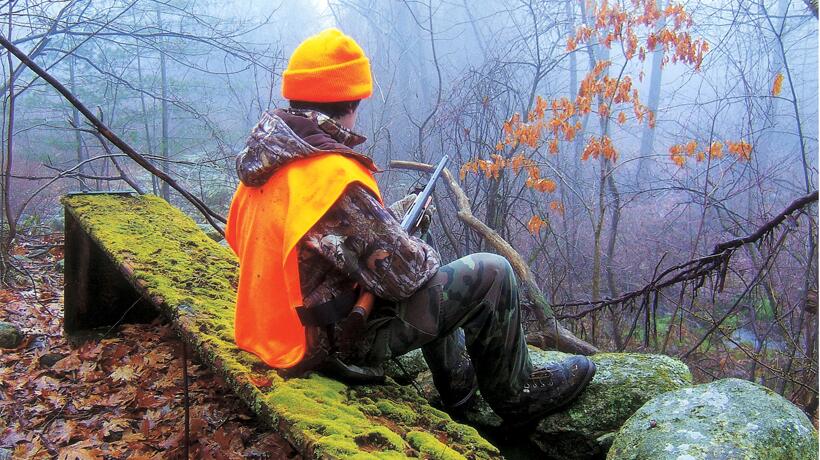- Division of Fisheries and Wildlife
Media Contact
Media Contact, MassWildlife

Be safe, be seen
Although hunting is one of the safest ways to enjoy the outdoors, wearing blaze orange will help minimize your chances of being mistaken for game animals during the hunting season. If you're wondering about what shade of orange and what amount works best, watch a short 5-minute video on the Effectiveness of Blaze Orange.
Legal blaze orange requirements
- All hunters during shotgun deer season and deer hunters during the primitive firearms season must wear at least 500 square inches of blaze orange material on their chest, back, and head. (Exception: coastal waterfowl hunters in a blind or boat.)
- All hunters on Wildlife Management Areas during the pheasant or quail season on WMAs where pheasant or quail are stocked must wear a blaze orange cap or hat. (Exception: waterfowl hunters in a blind or boat, and raccoon and opossum hunters at night.)
Will wearing orange impact my deer hunt? Some hunters may worry that wearing blaze orange will hurt their chances of harvesting an animal. While deer are not colorblind, they lack the ability to detect colors like red and orange from green and brown. Wearing blaze orange will not matter to the deer, but may save your life.
Treestand safety
Before you go
- Read, understand, and follow manufacturer's instructions.
- Practice using equipment at ground level with a partner, including suspension relief while in the harness and recovering from the suspended position.
- Inspect equipment before each use.
- Have a plan and let someone know where you'll be and when you plan to return.
- Keep emergency equipment like a knife, cellphone, flashlight, and/or whistle on you.
- Select a live, healthy, and straight tree that is large enough to support your weight and within the size limits recommended by the manufacturer. Never select a leaning tree.
While climbing
- Always use a Full Body Fall Arrest Harness System (FBFAHS).
- When climbing, keep three points of contact with the ladder at all times (both feet and one hand or two hands and one foot).
- Keep your weight centered.
- Always use a haul line to raise and lower equipment; never carry equipment while climbing. Firearms should be unloaded and arrows should be quivered while using a haul line.
In the stand
- Never place your stand higher than 16 feet.
- Remain attached to the tree at all times.
- Adjust the tether of your FBFAHS so that you will not hang lower than your stand in the event of a fall. There should be very little slack while seated.
If you fall
- Attempt to recover and return to your stand.
- Stay calm and call for help.
- Relieve pressure on your legs using your suspension relief device or exercise your legs by pushing against the tree until help arrives.
Treestand safety resources
- Watch a free, interactive online treestand safety course you can finish in about 20 minutes. Treestand safety protocols have changed over the years; make sure you have the latest information.
- For a list of certified products, go to the Treestand Manufacturer's Association Products List.
Basic firearm safety
- Treat every firearm as if it were loaded.
- Keep the muzzle pointed in a safe direction. Keep the action open and unloaded. Keep the safety “on” and your finger off the trigger.
- Be sure the barrel of the firearm is clear of obstructions. Check the chamber and magazine every time you pick it up. Only carry and use ammunition appropriate for your firearm.
- Never point a firearm at anything you do not intend to shoot. Agree to safe fields of fire for yourself and hunting companions and never swing beyond your area.
- Positively identify your target and what lies beyond. Make sure there is an adequate backstop when hunting or target practicing
- Unload your firearm when climbing a tree, crossing a fence, jumping a ditch or traversing slippery or steep terrain. Never pull a firearm toward you by the muzzle.
- Be aware of the potential for ricochet. Never shoot at a hard, flat surface or water.
- Unload firearms when not in use, leaving the action open. Transport and carry firearms unloaded and cased when traveling to and from the field or target practice
- Store firearms and ammunition separately in locked compartments and beyond the reach of children.
- Never use alcohol or drugs that can impair your judgment before or while shooting.
